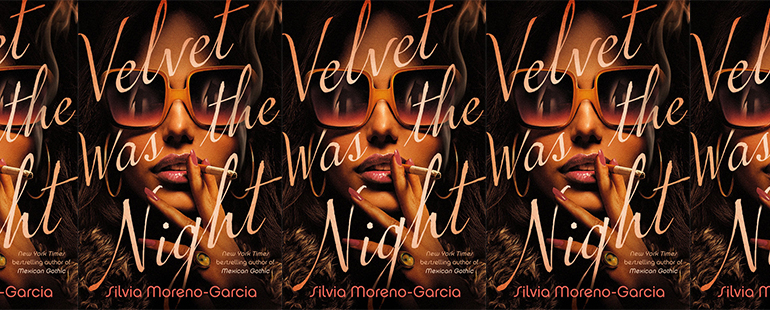“When you’re in the middle of it, you’re not necessarily doing the right thing or being the good character in a story”: An interview with Silvia Moreno-Garcia

“It is well established that the Hawks are an officially financed, organized, trained and armed repressive group, the main purpose of which, since its founding in September 1968 has been the control of leftist and anti-government students.” This confidential telegram from the United States Department of State opens Velvet Was the Night, Silvia Moreno-Garcia’s seventh novel, out this week, and her third foray into noir. Set in 1971, just three years after the Mexican government massacred student protestors at Tlatelolco, the novel follows Maite, a bored secretary, and Elvis, a member of the anti-communist paramilitary organization the Hawks, as they both find themselves looking for the same missing young woman, Leonora. Leonora, a neighbor and glamorous art student whom Maite admires from afar, knocks on Maite’s door one morning and asks her to feed her cat for a few days. But when Leonora doesn’t return, Maite goes searching for her, and finds herself enmeshed in Leonora’s complicated life of wealthy boyfriends and an art collective run by a feisty anti-government activist named Jackie. As Maite goes deeper into the mystery of where Leonora has gone, she realizes that she is not the only person looking for her. Elvis has been ordered by his superior—a mysterious figure named El Mago—to find Leonora as well and at every turn along his search, he encounters Maite instead.
The novel begins on the day of the Corpus Christi Massacre, an actual event wherein the Mexican-government-backed and CIA-trained Hawks attacked and murdered student protestors on the day of the Corpus Christi festival in 1971. Like the Tlatelolco Massacre in 1968, government involvement in the killings was similarly denied, and no participant was ever prosecuted. Both massacres occurred within the context of Mexico’s Dirty War, an internal conflict of the 1960s and 1970s between the PRI-ruled government and left-wing and guerilla groups. The Hawks represent this political backdrop in Velvet Was the Night, and serve as antagonists, with the apolitical Maite sitting like a fulcrum between those who wish to see Mexico reformed, like Leonora and Jackie, and those who, like El Mago, would fight to the death to see their nation’s character preserved.
Maite makes for a surprising and somewhat reluctant protagonist, as she abhors politics and is searching for Leonora only so that she can get rid of her cat. She spends her young life escaping into soap opera-like romance comic books, as her dreary job as an underpaid legal secretary offers little to enjoy in comparison. Elvis is also an unwitting hero in the story. A hired goon with a love of music and words, he feels an increasingly strong instinct that he may be on the wrong side of the clandestine fight for the soul of the nation. Fear and longing permeate the lives of both Maite and Elvis—fear of communists, fear of the government, fear of weakness, fear of ruin, as well as longing for adventure and the opportunity to live a remarkable and righteous life— and ultimately bring them together by the close of the novel. With deft plotting and lush scene-setting (and more than a little romance!), Velvet Was the Night is an edgy noir that is as escapist as it is politically provocative.
Moreno-Garcia’s work spans time periods and genres including fantasy, horror, and science fiction. Never wishing to repeat herself, but always with a fondness for strong characters who surprise even themselves with their courage and persistence, Moreno-Garcia’s novels have centered on a woman who can cast spells using music in her debut Signal to Noise (2015), a beautiful vampire on the run from a narco-vampire clan in the noir Certain Dark Things (2016), a bored young woman caught in her own lies in the crime thriller noir Untamed Shore (2020), and a Mexico City socialite trapped in a crumbling mansion with a family of eugenics-crazed Englishmen in Mexican Gothic (2020). Winner of numerous prizes including the Copper Cylinder Award, the World Fantasy Award, and the Locus Award, Moreno-Garcia is one of contemporary literature’s most fascinating and versatile voices. Originally from Mexico, Moreno-Garcia now lives in Canada with her family. I had the pleasure of speaking with Moreno-Garcia about her latest novel and the political circumstances prevailing in Mexico in the early 1970s. We also spoke about her ability to transcend genre constraints and how her writing is influenced by her early life spent in Mexico, as well as her current life in British Columbia.
Elizabeth Gonzalez James: Your novels and stories span many genres—fantasy, horror, gothic, noir. I even read in an interview that you had an idea for a Satanic panic story, which sounds amazing. When you’re deciding what project to work on next, do you start with a situation that intrigues you and then find the appropriate genre, or do you start with a genre and then look for a story within that context?
Silvia Moreno-Garcia: It depends on what story you’re talking about. Sometimes I just have an idea that I want to work on, and then later I decide basically how it might be packaged—whether people might call it noir or romance, that kind of situation. Then sometimes if I’m giving myself a challenge, I might start with the constraints of genre and try to figure how I can work within it. So if I tell myself I’m going to do a novella or short story, I might start thinking about what I can do and what I can’t do within the category, or how I can flip it around and how can I play with it. But it really depends on the project.
EGJ: For Velvet Was the Night, did you start out with the idea first or the genre, in this case, noir?
SMG: I started with an idea about a time period that I wanted to write about. And I thought that noir in that setting would work really well. I had done noir before, and I wanted to do a series of noir over a set period of time. So it was kind of part of this informal project of doing several noirs. So I was thinking, Yes, I’m going to do another noir next. I had done Untamed Shore before, which was a very different book. It takes place in Baja California in a rural setting in a very small community. But for Velvet Was the Night I wanted to do something that was radically different: a project in a big city with a completely different context with a big political background.
EGJ: Let’s talk about that political background. What was it about the Corpus Christi Massacre that first drew your interest? Did you have a personal connection to the story or to the attacks on protestors?
SMG: No, it’s just an interesting time period in Mexico that we didn’t talk about very much, officially. The dirty war, the massacre of 1968, and the events that happened after that were not featured in textbooks until three years ago, and the declassification of the archives [Dirección Federal de Seguridad] has happened over a period of several years. But again, it’s been kind of like this excavation process, I think, for the whole nation, of what happened and how it happened. And it’s a strange kind of situation when you know what happened unofficially—you hear about it, and it’s not like there haven’t been books published about ’68, and people write pieces about ’68 specifically, which was a big moment, which was the first kind of massacre that occurred. But, at the same time, it’s a strange thing when this is kind of happening in one space. But in the official space, nothing is going on, so nobody is going to trial. Nobody’s going to jail. Nobody’s being judged for this. So it’s a weird kind of unreality that you’re living in, and that has been the reality of Mexico for a really long time.
EGJ: I was not aware of the existence of the Hawks and their involvement in suppressing resistance to the government, but being Mexican American myself and knowing a fair amount of Mexican history, I was not surprised by their existence either. Do you believe readers will be surprised by the historical context behind Velvet Was the Night?
SMG: Yeah, I think if only because most readers don’t know anything about Mexico, to be frank. I think people’s perception of Mexico is very narrow, and very constrained. And at the whole, people’s perception of Latin America is very narrow, and very constrained. And most people don’t have an understanding of people from other nations outside the United States having lives and pasts and backgrounds, and how those pasts sometimes intertwine with the United States. So the United States intervened in very, very many Latin American nations when it was afraid of communism, and it destabilized [governments], or caused wars in many parts of the world, including in Latin America, and the result of that destabilization is something that you can see nowadays. So what happened in the sixties and the fifties, in the seventies and the eighties—it’s something that has echoes through time. So sometimes people will look at things like the problem with undocumented people going into the United States—and most of the undocumented people going into the United States nowadays are not from Mexico, but Central America. And that is because of all the conflicts that the United States instigated there in a certain time period. It created this kind of bubbling cauldron of problems that overflowed and is now affecting people in the United States. And now those regions have become poor, unstable, and riddled with criminal issues, and that was because the United States caused that, and before that, there were colonial issues and exploitation of resources. But that’s just one example of how people can turn and look at migrants, and say, Oh, those dirty, stupid people! without understanding that they created that problem. It’s kind of like a Frankenstein sort of issue where you make the monster and then you don’t recognize the paternity of it.
EGJ: Is that what you hope readers come away with? With a deeper understanding of the United States’ complicity in these issues?
SMG: I don’t write didactically. I think if you want to get a good understanding of political issues or historical issues, for example, you should read history and politics books. I’m not a person who is here to teach you anything in an academic way. And I think it’s also a lot of weight to tell somebody from a visible minority group to always be your teacher in every single matter that has to do with history or social issues. But I do hope readers find it interesting and maybe are surprised and look into this and maybe other texts, whether they explicitly are related to socio-political problems, or whether they look for other crime books that maybe are not related to this, in order to extend their vision of what Latin American writing is like, or what Latin American people can write. But yeah, I’m not here to be the Latin American Wikipedia for folks.
EGJ: That’s very well said. Moving on to Maite—she’s such an engaging character, from her obsession with romances, to her willingness to lie and steal, and just how desperately she wants out of her life. And yet throughout the novel she’s also an innocent bystander, in a way. She’s only drawn into the story, kind of despite her better judgement. How did you arrive at her as one of your principal characters rather than Leonora or Jackie—women with more direct involvement in the various plots going on?
SMG: One of the things that I was interested in when I was doing my research was looking at how leftist movements had been represented in the media and the newspapers and the magazines that were coming out at the time. And it’s not like the portrayals were positive. There were obviously some publications that were more favorable towards the left, that were kinder to the movement. But a lot of the mainstream media talked about communist agitators, and communism being a foreign plot to destroy Mexico. About these hippies being deviants and things like feminism and certain rights of women being an attempt to destroy the nation. Talking to some of my relatives, it was very interesting to see how people on the ground were not necessarily perceiving the same things that you’re seeing, through time, decades later. I can tell you that massacring a group of students is not good, right? But at the time, you know, if I had been there, I don’t know if I would have said that. And we see that today with other kinds of political movements. You know, it’s not like everybody takes to the streets and engages in revolution when there’s problems. In fact, most people stay home, and they do their job 9 to 5. So sometimes people have these wild ideas of what they would do if they were in a moment of change or a revolution, and these ideas have nothing to do with the reality of what really happens. And also on the ground, when people look back, it’s the same thing when we talk about things like women’s rights or minority rights: everybody always seems to say that they were on the right side of history. Oh, I marched for women’s rights, or [Oh, I marched for] Black rights. And that’s not true. Most people did not. Even nowadays most people do not. And when you see the protests that have been happening in Mexico about women’s rights recently, the media coverage is actually very similar to what you would have seen in the late sixties and the seventies, where people in Mexican media and people online and social media were saying things like, Oh, but why are these women putting graffiti on statues or acting like savages? or This is not the way to protest. And so you get the sense that we have a very righteous vision of the past, but when you’re in the middle of it, you’re not necessarily doing the right thing or being the good character in a story.
EGJ: And Maite stands in for that.
SMG: Yeah, and the other thing was that—and I didn’t include this in the book—but this is also around the time period when the murders of San Miguel Canoa happened. There were some workers from [Universidad Nacional Autónoma de México], the national university, who were going hiking in this very small, very rural area, one day in the 1960s. And the weather changed, and they couldn’t complete the hike that they were doing. So they go into this small town and they ask to stay there overnight, and four of them end up being murdered. A local priest, who is kind of like the leader of the town, thinks that they are communists who have come to destabilize the town, and he tells the people in the town to lynch them, which they do.
EGJ: Oh my God.
SMG: Yeah. So you have to understand that this is not a time period in which everybody is looking at leftist politics, especially communism, with a positive attitude. In San Miguel Canoa, one of the reasons why the people lynched this group of university workers that were just stopping by was because they were not informed about what was going on in other parts of the world. They did not understand what was going on in the city and, you know, in the urban centers where people were engaged in student movements [and] that kind of stuff. In the small towns they thought there was this huge threat to their community.
So I’m taking that point of view and talking about that rather than talking about, for example, what somebody who was in the middle of the leftist movement might have been doing. There are a lot of accounts about that from people who were there at the time. And I think if you want to read that point of view, you can look at a lot of the work that has been done, about some of the political prisoners and the activists and the folks who were in that milieu. I’m more interested in things like the turncoats, the spies that were inside movements, and the normal people who were not doing anything, or were even calling on their neighbors and accusing them of being communist.
EGJ: Yeah, another character continually tells Maite, You don’t read the papers, do you? Music permeates the narrative, too, in such a beautiful way. Elvis and Maite are both audiophiles, and music is always being referenced either as characters play records or hear ambient music in the background. In the afterword, you write about how the government used repression of music as another way to suppress resistance. Was music, and its intertwining with the politics of the early 1970s, always an element of this novel, or did that evolve over time?
SMG: It was an element that I didn’t want to include initially very heavily because I had done a book about music. My first novel was called Signal to Noise, and I don’t like to repeat myself, so I didn’t want to repeat myself. So I was trying to keep music references out and cutting things that referred to music. And then at one point when I was doing some research, somehow music kept popping up again and again. And when I finally decided that I did need to include it instead of taking it all out and trying to censor the manuscript was when I was reading this account of somebody who was a prisoner, an activist taken to jail by the Mexican government. He was talking about how they were tortured, and how the people who tortured him would put the radio on. And it was tropical music. So not the news or anything, so they wouldn’t know what was going on out in the world. And this tropical music was very annoying to them. And this prisoner spoke about a moment when somebody came to get him from his cell and they were going to torture him, and he mentioned the singer that was on the radio at that moment. And that’s when I decided that I had to include music. Because if you can remember who was singing when you were being tortured, I think that says something. And so I decided that I couldn’t scrub the book clean of any music.
EGJ: How did growing up in Mexico shape you as a writer? And I know you now live in Canada. In what ways does Canada shape you as a writer? SMG: Well, Mexico is my past. It’s part of my formative years and kind of like, embedded in my flesh in a way, sometimes in a literal way. But Canada is my present. It’s the place where I live and interact with every day. I’m speaking in English right now, and I’m writing in English. So I am not one thing or another anymore. I am no longer a quote unquote, fully Mexican writer, and I am not a quote unquote, fully Canadian writer. I am both. Both things at the same time.



